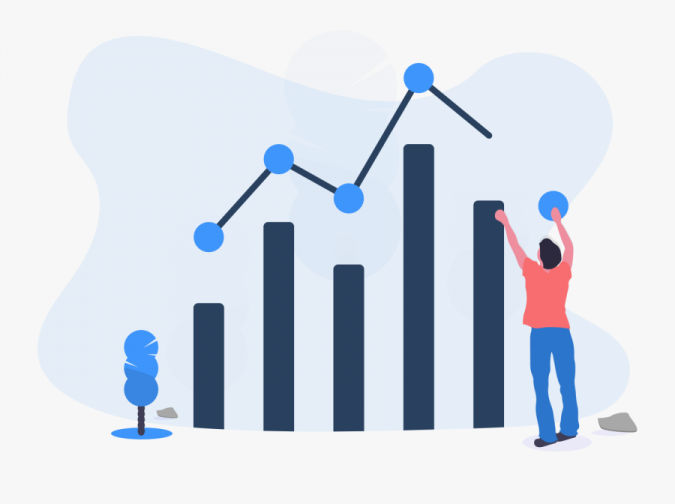Data visualization only helps to streamline data and information for a better understanding.
Data visualization only helps to streamline data and information for a better understanding. Data visualization with Tableau is a technique through which the users can improve the visual aspects of their data. The visual representation is constructive for a growing organisation. Many software related to data analytics uses data visuals for better outcomes and relational studies. Softwares like Excel and VBA use data presentation for an impactful approach.
Excel has risen as the application that helps users to store, record and analyse any form of data. Data management and allocation are the USP for this application. MS Excel has many tools with different functionality based on numerous requirements. Excel holds the key to data visualisation.
Graphical representation of information and data is known as Data visualisation. This segment has many enhanced tools that would help the user to represent the allocated data for better outcomes and bigger purposes. Those enhanced elements mainly are the following:
1. Charts
2. Maps
3. Graphs
These tools of data visualization helps the audience to understand the trends, outliers and patterns in data by providing an accessible way to approach them.
Once the world of Big Data is considered, then tools of data visualisation and related technology are very essential for simplify and analyse the massive amount of data and information and eventually it will assist in data-driven decisions.
Benefits of Data Visualisation.
People in society are prone to accept and receptive to colours. It is easier for the audience to identify different sorts of colours from distance, this goes to prove that our culture is full of visual information, from movies, advertisements, society, people, trends, etc.
Data visualisation is a form through which the tools enhance the visual experience of the users and help them to receive the message completely. There are many tools available for these purposes but effectively charts, graphs and maps will disseminate the trends and outliers to the users. For example, the storytelling format but with a purpose, because once users see something with visual graphics, it comes easier for them internalise it quickly.
Big Data
Big data is on the rise, it has geared up in the industry. Therefore, data visualisation could assist Big Data as the key tool for enhancing the visual representation of the trillions of rows of the generated data. Visualisation of data is the process of simplifying the content to help people to understand and highlight data trends and outliers. The sole of data visualisation is to tell an effective story without any hindrance.
Although data visualisation is not making the data more colourful or putting graphics to make data look attractive. The true form of data visualisation is a delicate balancing act between the form and functionality. For example, even the plain without any graph may hold a fair and important, however, it is boring in nature but with an important point. Sometimes the most stunning visuals would fail to deliver the required message through data representations.
Why data visualisation is important for professionals?
Almost every field or sector would require data visualisation as a tool for better representations and tools to simplify and analyse data. From government, finance, marketing, history, consumer goods or services, everyone roots for a better understanding of data.
These tools would help the users to make their life easy. It has many desirable real-life based applications which allow the users to relate with the offered applications and how it would help them. As mentioned before that if the data visualisation is prominent for almost all the fields. Therefore, the suggestion to all the potential users and professionals to equip themselves with the offerings of the applications. To grow along with others, it is important for the user to convey the point without any noise, the better he/she can leverage the point and it can be achieved by more effective data visual representation.
As the skill sets are changing around the world and the world has become more data-driven. Every organisation need to change their decision-making process to better results and outcomes. Mostly all data states the obvious attached to it, like who, what, when, where and how? Hence the users must represent data that would help to make a decision and use visuals to tell the stories. Data visualisation stands right between analysis and visual storytelling.
Types of visualisation
Immediate picture that comes when we talk about visualisation is simple graph charts or pie charts. These tools are an integral part of visualising data and common baseline for many graphic graphics, the correct visual representation will not only inform the audience but it would level up the decision-making process.
Common general types of data visualisation:
· Charts
· Tables
· Graphs
· Maps
· Infographics
· Dashboards
Specific examples of methods:
· Area Chart
· Bar Chart
· Box-and-whisker Plots
· Bubble Cloud
· Bullet Graph
· Cartogram
· Circle View
· Dot Distribution Map
· Gantt Chart
· Heat Map
· Highlight Table
· Histogram
· Matrix
· Network
· Polar Area
· Radial Tree
· Scatter Plot (2D or 3D)
· Streamgraph
· Text Tables
· Timeline
· Treemap
· Wedge Stack Graph
· Word Cloud





